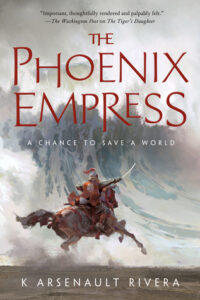Amazon Affiliate Link | Bookshop.org Affiliate Link
K Arsenault Rivera’s debut novel, The Tiger’s Daughter, ended with a lot of stories left to tell. Both of its main characters, Shefali and Shizuka, had gone on perilous and dramatic adventures only hinted at in the book itself, and their future clearly holds challenges yet to come. But still it ended, closing out with an emotional and satisfying conclusion despite so many unanswered questions. I knew The Tiger’s Daughter was the first book of a trilogy, but I have to wonder if the author knew when she wrote it. Because while its sequel novel, The Phoenix Empress, feels like a natural extension of where things left off, in some ways it feels far more dependent on being part of a trilogy than The Tiger’s Daughter ever did.
Before I worry fans of the first book, let me say that if you liked The Tiger’s Daughter, you will enjoy The Phoenix Empress. For a novel so concerned with how years of trauma can change someone, both Shefali and Shizuka felt completely true to the characters I fell in love with. It’s written like a reverse of The Tiger’s Daughter, with epistolary chapters from Shizuka’s perspective interspersed with present-day narration from Shefali. Getting to suddenly see through Shizuka’s eyes adds a compelling new depth to the story we already know; learning that many of her moments of arrogance and hubris were fueled by uncertainty and fear deeply humanizes her as a character. Also, hearing Shizuka call Shefali handsome for the first time was a revelation—I saw the butch/femme dynamic between them during the first book, but having it signposted so explicitly in the second was spectacular.
But for all that I loved, The Phoenix Empress did have some peculiarities that stuck out to me. The real heart of the book is Shizuka’s story of what happened to her during Shefali’s time away, and how she became empress. After that story ends, however, the book still has a good many chapters left to go, and it’s almost all exposition setting up the last book in the trilogy. These chapters didn’t undermine the emotional weight of Shizuka’s tale, but I can’t say that they built upon it either. Despite still being good writing with good characters, I don’t think the ending served The Phoenix Empress quite as well as it serves the trilogy as a whole.
Overall, The Phoenix Empress does a better job of being part of a fantasy trilogy than it does at being a novel. However, it is still very good, and as a follow up to The Tiger’s Daughter it certainly doesn’t disappoint. Like its predecessor, it can be very intense at times; none of the content warnings listed below are lingered on for very long, but if even a mention is too much for you, you may want to pass this series by. But if you read and loved the first book like I did—well, then I can’t imagine much is going to keep you from reading every book that follows.
Content Warnings: body horror, drowning, gore, cannibalism, mind control, vomiting
Samantha Lavender is a lesbian library assistant on the west coast, making ends meet with a creative writing degree and her wonderful butch partner. She spends most of her free time running Dungeons & Dragons (like she has since the 90’s), and has even published a few adventures for it. You can follow her @RainyRedwoods on both twitter and tumblr.


